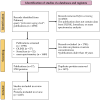Proteomic Markers of Aging and Longevity: A Systematic Review
- PMID: 39684346
- PMCID: PMC11641128
- DOI: 10.3390/ijms252312634
Proteomic Markers of Aging and Longevity: A Systematic Review
Abstract
This article provides a systematic review of research conducted on the proteomic composition of blood as part of a complex biological age estimation. We performed a comprehensive analysis of 17 publicly available datasets and compiled an integral list of proteins. These proteins were sorted based on their detection probability using mass spectrometry in human plasma. We propose this list as a basis for creating a panel of peptides and quantifying the content of selected proteins in the format of a proteomic aging clock. The selected proteins are especially notable for their roles in inflammatory processes and lipid metabolism. Our findings suggest, for the first time, that proteins associated with systemic disorders, including those approved by the FDA for clinical use, could serve as potential markers of aging.
Keywords: aging; biological age; biomarkers; blood plasma proteome; high-copy proteins; knowledge databases; longevity; targeted mass spectrometry.
Conflict of interest statement
The authors declare no conflicts of interest.
Figures



Similar articles
-
Factors that influence parents' and informal caregivers' views and practices regarding routine childhood vaccination: a qualitative evidence synthesis.Cochrane Database Syst Rev. 2021 Oct 27;10(10):CD013265. doi: 10.1002/14651858.CD013265.pub2. Cochrane Database Syst Rev. 2021. PMID: 34706066 Free PMC article.
-
Blood biomarkers for the non-invasive diagnosis of endometriosis.Cochrane Database Syst Rev. 2016 May 1;2016(5):CD012179. doi: 10.1002/14651858.CD012179. Cochrane Database Syst Rev. 2016. PMID: 27132058 Free PMC article.
-
Interventions to reduce harm from continued tobacco use.Cochrane Database Syst Rev. 2016 Oct 13;10(10):CD005231. doi: 10.1002/14651858.CD005231.pub3. Cochrane Database Syst Rev. 2016. PMID: 27734465 Free PMC article.
-
Systemic pharmacological treatments for chronic plaque psoriasis: a network meta-analysis.Cochrane Database Syst Rev. 2021 Apr 19;4(4):CD011535. doi: 10.1002/14651858.CD011535.pub4. Cochrane Database Syst Rev. 2021. Update in: Cochrane Database Syst Rev. 2022 May 23;5:CD011535. doi: 10.1002/14651858.CD011535.pub5. PMID: 33871055 Free PMC article. Updated.
-
Comparison of self-administered survey questionnaire responses collected using mobile apps versus other methods.Cochrane Database Syst Rev. 2015 Jul 27;2015(7):MR000042. doi: 10.1002/14651858.MR000042.pub2. Cochrane Database Syst Rev. 2015. PMID: 26212714 Free PMC article.
Cited by
-
Model Organisms in Aging Research: Evolution of Database Annotation and Ortholog Discovery.Genes (Basel). 2024 Dec 25;16(1):8. doi: 10.3390/genes16010008. Genes (Basel). 2024. PMID: 39858555 Free PMC article.
-
Ovarian Cancer: Multi-Omics Data Integration.Int J Mol Sci. 2025 Jun 21;26(13):5961. doi: 10.3390/ijms26135961. Int J Mol Sci. 2025. PMID: 40649740 Free PMC article. Review.
-
Premature aging and metabolic diseases: the impact of telomere attrition.Front Aging. 2025 Mar 31;6:1541127. doi: 10.3389/fragi.2025.1541127. eCollection 2025. Front Aging. 2025. PMID: 40231186 Free PMC article. Review.
References
Publication types
MeSH terms
Substances
Grants and funding
LinkOut - more resources
Full Text Sources
Medical

